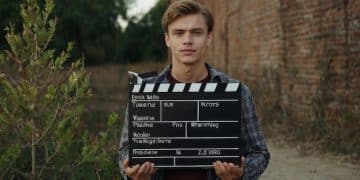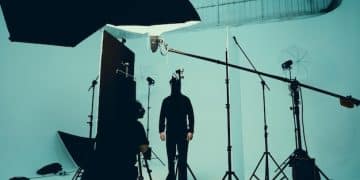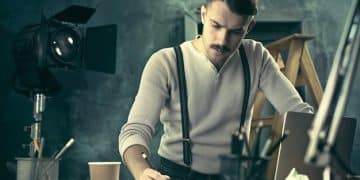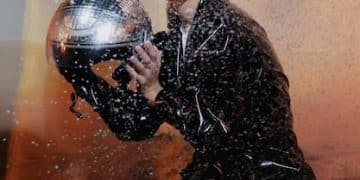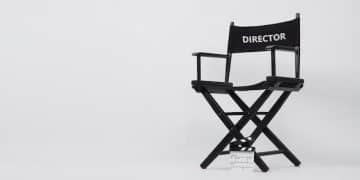Short Film Editing: Techniques for US Filmmakers’ Success
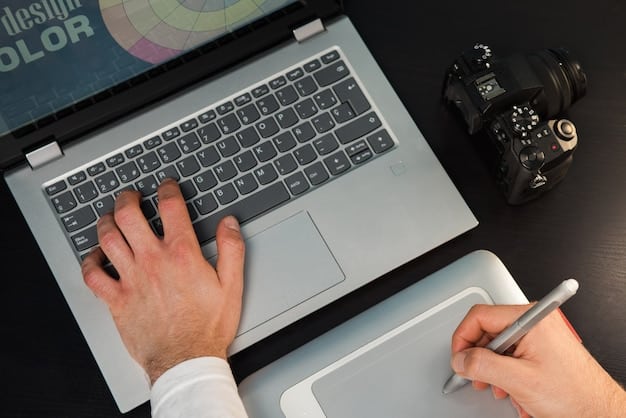
Short film editing techniques are essential for US filmmakers to create compelling narratives by mastering pacing, rhythm, and emotional impact, ultimately leading to success in film festivals and audience engagement.
Are you a US filmmaker looking to elevate your short films? Mastering short film editing techniques can be the key to unlocking your film’s full potential, captivating audiences, and achieving success.
Essential short film editing techniques for US filmmakers
Editing is where a film truly takes shape. It’s more than just chopping up footage; it’s about crafting a story, managing emotions, and keeping the audience engaged. Here’s how to master the essentials for success.
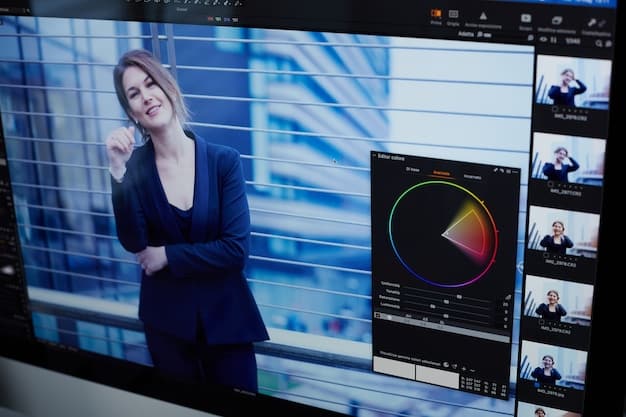
Understanding pacing and rhythm
Pacing and rhythm are the heartbeat of your film. Understanding how to manipulate them can dramatically impact the viewer’s experience. Slow, deliberate pacing can build suspense, while quick cuts can create excitement.
Mastering transitions
Transitions are the bridges between your shots. They can be subtle or dramatic, but they should always serve the story. Avoid overuse of fancy transitions that distract from the narrative.
- Cut: The most basic and commonly used transition. It provides a seamless jump from one shot to another.
- Fade: A gradual transition to or from black or white, often used to indicate a passage of time or a change in scene.
- Dissolve: One shot gradually blends into another, creating a sense of connection or transition between scenes.
- Wipe: One shot is replaced by another by moving a boundary line across the screen. Use sparingly as it can be distracting if overused.
The effective blending of pacing, rhythm, and transitions allows for storytelling to breathe and resonate, helping to sculpt the emotional journey audiences undertake. Choosing the right flow helps create an immersive cinematic experience.
The art of storytelling through editing
Editing is not just about assembling footage; it’s about telling a story. As an editor, you’re a storyteller, shaping the narrative and guiding the audience’s emotions.
Creating emotional impact
Editing can evoke a wide range of emotions in the audience. Choosing the right shots, timing them effectively, and using music can all contribute to creating the desired emotional response.
Building suspense and tension
Short film editing helps to construct suspense by strategically withholding information and prolonging key moments, thus heightening the tension and deeply involving the audience in the unfolding drama.
- Cross-cutting: Cut between two related scenes happening simultaneously to build tension.
- Montage: Use a series of short shots to condense time or convey a particular mood.
- Sound design: Use sound effects and music to enhance the emotional impact of the scene.
- Juxtaposition: Arrange shots so the audience can draw their own conclusions through visuals.
Building suspense and tension is crucial in storytelling. By carefully controlling the flow of information, editors can keep audiences on the edge of their seats. Techniques like cross-cutting and strategic use of sound design serve to create layers of anticipation and excitement.
Technical skills every short film editor needs
Beyond the creative aspects, a short film editor needs a solid foundation of technical skills. Knowing your way around editing software and understanding the technical aspects of filmmaking is crucial.
Software proficiency
Mastering editing software like Adobe Premiere Pro, Final Cut Pro, or DaVinci Resolve is essential. Each software has its strengths, so choose the one that best fits your workflow.
Color correction and grading
Color correction and grading can dramatically enhance the visual appeal of your film. Understanding how to balance colors and create a specific mood is a valuable skill.
- White balance: Adjust the color temperature to ensure accurate colors.
- Exposure: Correct over or underexposed shots.
- Color grading: Create a specific look and feel for your film using color.
- Skin tones: Pay special attention to making skin tones look natural and healthy.
Mastering technical skills is paramount for any short film editor aiming for professional excellence. Software proficiency allows for efficient and precise editing, while expertise in color correction and grading elevates the visual appeal of the film, ensuring a polished and visually compelling final product.
Collaborating with the director and crew
Editing is often a collaborative process. Working closely with the director and other crew members can lead to a better final product.
Understanding the director’s vision
Before you start editing, make sure you understand the director’s vision for the film. Discuss their goals, themes, and overall aesthetic.
Communicating effectively
Being able to communicate your ideas and suggestions clearly and respectfully is essential. Be open to feedback and willing to compromise.
Effective communication and a clear understanding of the overall cinematic vision helps achieve more creatively balanced results. This unified direction ensures that the final short film resonates with both the creative team and the audience.
Collaboration will help develop a more polished sense of creative and technical direction. This collaboration also enhances the film’s ultimate impact and effectiveness.

Advanced editing techniques to elevate your short films
Once you’ve mastered the basics, you can start experimenting with more advanced techniques to take your short films to the next level.
J and L cuts
J and L cuts involve overlapping the audio and video from different shots. A J-cut is when you hear the audio from the next shot before you see it, while an L-cut is when you see the video from the next shot before you hear its audio.
Match cuts
A match cut is a transition where an element from one shot is visually matched to an element in the next shot, creating a seamless and often symbolic connection.
- Visual matches: Matching the shape, color, or composition of two different objects or scenes.
- Conceptual matches: Matching the idea or theme of two different shots.
- Sound matches: Create a similar sound design in each shot.
Advanced editing techniques can significantly enhance the cinematic quality and storytelling depth of short films. Techniques such as J and L cuts create seamless transitions and engage audiences, while match cuts invite viewers to draw deeper connections between different scenes, enriching the overall narrative experience.
Building a portfolio and getting your work seen
Creating great short films is only half the battle. You also need to build a portfolio and get your work seen by the right people.
Creating a demo reel
A demo reel is a short compilation of your best work. It should be visually appealing and showcase your range of skills.
Submitting to film festivals
Film festivals are a great way to get your work seen by industry professionals and gain recognition. Research festivals that are a good fit for your film and submit your best work.
Showing your work at film festivals can greatly impact recognition, help build your portfolio and attract potential collaborators or employers, setting a promising trajectory for long-term success.
| Key Aspect | Brief Description |
|---|---|
| 🎬 Pacing and Rhythm | Control the speed and flow of your film to evoke specific emotions. |
| ✂️ Transitions | Use cuts, fades, and dissolves to smoothly connect scenes. |
| 🎨 Color Correction | Enhance the visual appeal and set the mood with precise color adjustments. |
| 🤝 Collaboration | Work closely with the director and crew for a unified vision. |
FAQ
▼
The most important aspect is storytelling. Editing should enhance the narrative and evoke the desired emotions in the audience. Every cut should serve the story by creating compelling visual connections.
▼
Choose transitions that are appropriate for the tone and pace of your film. Use cuts for seamless scene changes, fades for time lapses, and dissolves for connecting related scenes, and avoid overuse of fancy transitions.
▼
Color correction enhances the visual appeal and sets the mood of your film. Balancing colors and creating a specific look can make your film more engaging and professional, ensuring visual consistency.
▼
Use short cuts for fast-paced scenes and longer takes for slower, more emotional moments. Adjust the rhythm of your cuts to build suspense, excitement, or other desired emotions in the audience. The goal is to create an emotionally connected experience for the audience.
▼
Popular choices include Adobe Premiere Pro, Final Cut Pro, and DaVinci Resolve. Premiere Pro is versatile, Final Cut Pro is user-friendly for Mac users, and DaVinci Resolve is exceptional for color grading.
Conclusion
Mastering short film editing techniques is crucial for US filmmakers aiming to create compelling and successful films. By focusing on storytelling, technical skills, and collaboration, you can elevate your work and connect with audiences on a deeper level.
